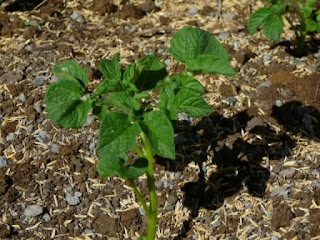I apologize for the recent lack of blog posts. My computer and I've been experiencing problems. The computer refused to boot up, and my food refused to go down (without a fight) for almost two weeks. About the time the computer and I got back on track, some good friends arrived for a visit. But they're off touring Costa Rica now.
Okay, now for today's topic, potatoes. I love growing potatoes. Any root crop, actually. Harvest time is kind of like a treasure hunt. I grew potatoes successfully for almost 10 years in South Carolina. I liked Yukon golds the best. Consumed fresh from the garden (cooked, of course), they almost melt in your mouth. I never thought something as mundane as a potato could be so delicious.
I asked my Costa Rican neighbor, who is a gardener, about growing potatoes. He's originally from Cartago, Costa Rica's potato-growing capital. I said, "It'd be best to grow them in the dry season, don't you think." "Oh no," he answered. "Potatoes are easy. You can plant them anytime, even September and October [the two rainiest months]." "Really," I replied. "I'll have to give it a try."
I asked around for seed potatoes, but found none. My neighbor and a brother-in-law, who lives in Cartago, each promised to bring me some seed potatoes, but they somehow never got around to it. So, I got some potatoes with good eyes on them at the supermarket, cut them up, and planted them in November, the last month of the rainy season. About ten days later potato sprouts began to appear in the garden. Within a few more days they had all wilted. I dug up the potato cuttings and found that they were all rotten, and stunk terribly. I'd never had any serious problems growing potatoes back home. An internet search produced the possibility of viruses or bacteria, I couldn't tell which.
So I posted a message on the internet to the Costa Rica gardening group. I got some very good responses. Apparently at one time growing potatoes was very easy in Costa Rica. Then someone brought in some potatoes illegally from Colombia, which had all kinds of diseases. The diseases spread, and now potato growing can be quite a challenge here.
I also checked on the internet for ways to combat potato diseases. After my research, I decided to try again, using some precautionary measures. Basically you want to start with disease-free potato seed, and you want to reduce the possibility of infection once they're planted. So, I did the following:
(1) In order to keep the soil as dry as possible, I dug up a space in one of the raised beds and replaced most of the soil with sand and rice hulls. The sand was to promote good drainage. The rice hulls were to provide organic matter, as a substitute for fresh compost, that was likely to contain at least some diseased plant material in it.
(2) I cut up the seed potato with a knife sterilized with a solution of water and chlorine.
(3) I sterilized the potato pieces with the same kind of solution, and let the pieces cure for three days.
(4) I sterilized the potato pieces a second time before planting.
(5) I planted them in the dry season.
As you can see in the picture, I now have potato shoots about four inches high, and they look very healthy. I'm overjoyed at the prospect of growing and eating my own potatoes again, and although I might be counting my chickens before they hatch, at least I've gotten the potatoes off to a good start.
Happy gardening!





